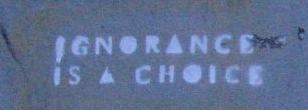Whomever coined the phrase “ignorance is bliss” has not yet read Hengstler (2014) where the author lays out a continuum of FIPPA compliance BC educators can fall under. Ignorance can be very damaging, especially when the privacy of students is in question.

“Ignorance is a choice Tony…no really it is…” by Jonathan Kellenberg. Retrieved from https://flic.kr/p/AVD1. CC BY 2.0. Adapted by Stephanie Boychuk.
The readings for this topic widened my view of what “damaging” could mean in relation to student privacy as well. For example, although I had considered risks associated with identifiability and data storage, I had not really considered the students’ copyright to their work being breached through online posting (Hengstler, 2013). When I post my own work, I usually take the time to add a creative commons license (if appropriate) but am now considering what would be the best course of action for students. In my context, working with faculty who teach adult learners, it would be the students’ choice to apply a licence or not – but they would need to be educated on what their intellectual property rights were and what it would mean to apply a different license to their work.
I also feel the having a specific, drawn out plan to handle potential incidents that occur is necessary, but is also something I had not thought of before (Hengstler, 2013). Even relatively isolated uses of social media – a faculty member using a Google Doc for a formative wiki project for instance – it would be prudent to lay out solutions to potential issues. I believe this is something that could be useful for the entire campus community, and perhaps increase the awareness of and comfort in using these tools.
References
Hengstler, J. (2013). A K-12 primer for British Columbia teachers posting students’ work online. Retrieved from http://jhengstler.wordpress.com/2013/05/17/a-k-12-primer-for-british-columbia-teachers-posting-students-work-online/
Hengstler, J. (2014). The compliance continuum: FIPPA & BC educators. Retrieved from http://jhengstler.wordpress.com/2014/04/24/the-compliance-continuum-fippa-bc-public-educators/

